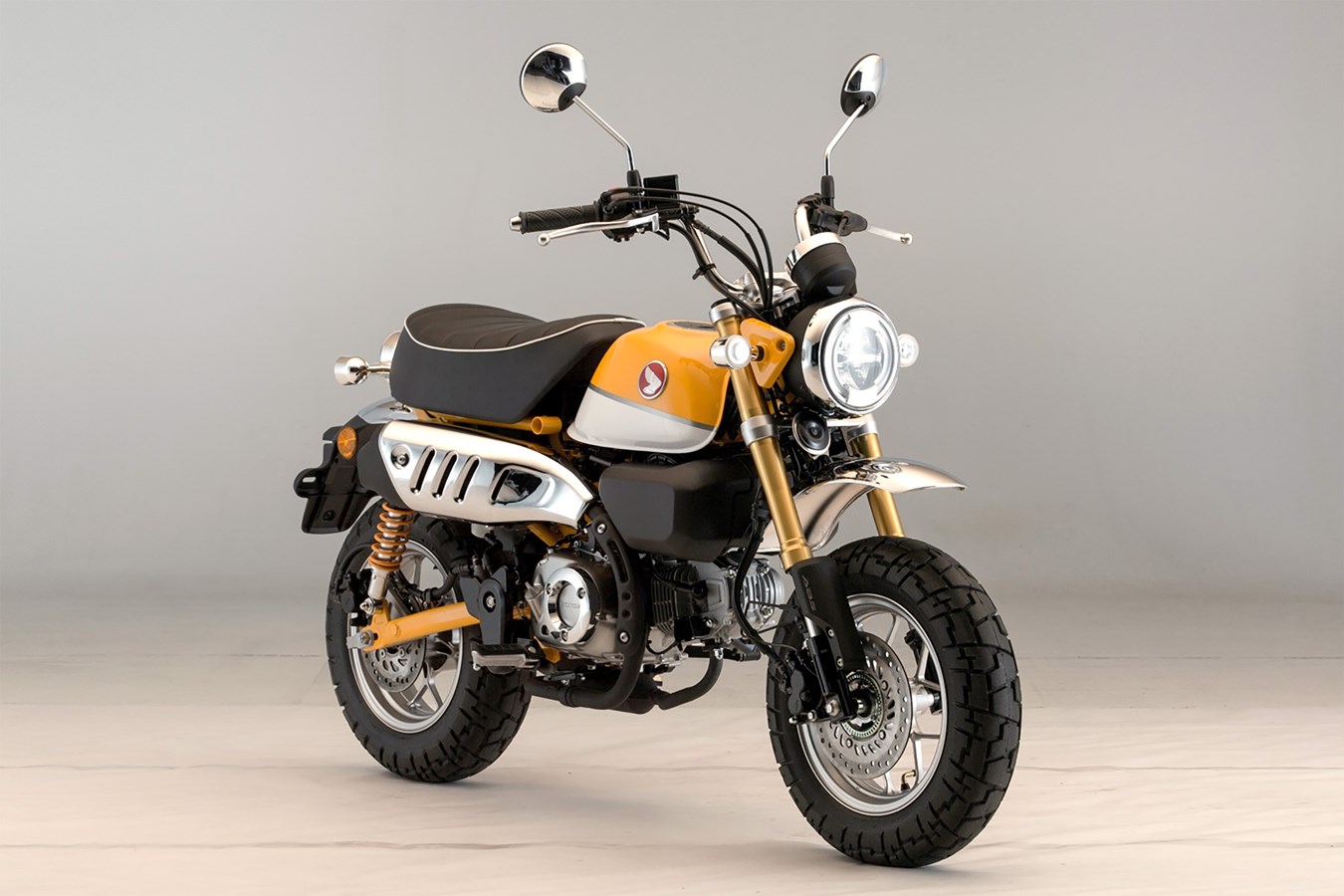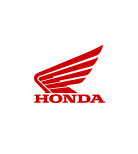2018 HONDA MONKEY

Honda’s genuinely iconic mini-bike is re-imagined for the present day, with styling that draws heavily on the original, complemented by modern, premium touches such as USD forks, twin rear shocks, LCD instruments, IMU-based ABS and full LED lighting. Its 125cc air-cooled engine delivers 6.9kW power, and fuel efficiency of 67km/litre; wet weight is a mere 107kg.
Contents:
1. Introduction
2. Model overview
3. Monkey milestones
4. Technical specifications
1. Introduction
The Honda Monkey bike is perhaps most widely known as a groovy icon of the 1970s, but it first saw the light of day in 1961. Originally developed as a 49cc child’s plaything for Tama Tech, an amusement park in Tokyo, it proved so popular that a road-going version was developed, which was initially exported to America and Europe in 1963, with a distinctive chrome tank, folding handlebars and 5-inch diameter rigidly-mounted wheels.
Its popularity was based on a cute, instantly-likable design, tiny dimensions and ultra light weight - which made it a whole load of fun around town. By 1969 its wheels had increased to 8-inch in diameter and from 1970 it gained even greater popularity, when the addition of quick-detach forks meant it would fit into the trunk of a small car.
By 1978 – a point that marked the start of real prime time for the Monkey – the machine had been re-styled with a teardrop style fuel tank, and became hugely popular with legions of RV (Recreational Vehicle) drivers in need of convenient transport to use once they were parked up. And this is where and when the cheeky Monkey really cemented its place in millions of hearts; with its 3-speed gearbox and centrifugal clutch (which needed no ‘traditional’ motorcycle skill to operate) it gave thousands of riders their first experience of twisting the throttle on a powered two wheeler.
Because it was so much fun, and so easy to ride, it did more to sell the concept of motorcycles to a wider public than perhaps any other machine. With its chunky tyres, mini-‘ape’ style handlebars, miniscule fuel tank and big, squashy seat the Monkey look is unmistakably of its time, but – just like the affection in which it is held – also timeless.
2. Model overview
- Styling, paint and chromed parts draw heavily on the original
- 125cc air-cooled engine delivers 6.9kW power, 11Nm torque and 67km/l
- Steel frame, USD forks, twin rear shocks and 12-inch diameter tyres
- Wet weight of 107kg, with wheelbase of 1155mm and 775mm seat height
- All lighting is premium LED
After the modern-day success of the sharp-suited MSX125, which proved the desire for a funky, pocket-sized town run-around, it was time for the Monkey name to return, reborn and ready for life in the 21st century city.
Naturally the classic Monkey style had to provide the cues for the new model. A trapezoid silhouette highlights the compact length, while adding depth and substance to its stance. Simple, curved surfaces are designed independently of each other and feature throughout.
The glossy 5.6L fuel tank, finished in the same paint colour as the frame, swing arm and rear shocks, crowns the machine, and proudly wears a historical 3-D Old Wing design Honda logo. Chromed steel high-level front and rear mudguards – plus the evocatively-stamped exhaust shield, circular mirrors and high-rise handlebars – all pay homage to the original.
Modern technology is fully present within the evocative reincarnation of the classic look: a digital full-LCD circular meter features speedometer (which winks playfully when the ignition is turned on), odometer with two trip meters and six-segment fuel level indicator; all lighting is LED; the ‘wave’ pattern key (which also wears the Old Wing motif) features an ‘answer back’ system that makes the lights flash at the push of a button to allow easy location in crowded car parks; the single channel ABS system operates with an IMU to mitigate rear ‘lift’ under strong braking.
As for the power unit, true to its origins, the Monkey’s horizontal SOHC 125cc single-cylinder engine is simple, robust and tuned to deliver useful about-town performance. Air-cooled, with bore and stroke of 52.4 x 57.9mm and compression ratio of 9.3:1, fed by PGM-FI, it produces 6.9kW @ 7,000rpm and 11Nm @ 5,250rpm. The gearbox is 4-speed and the engine returns fuel economy of 67km/l (WMTC mode).
The Monkey’s steel backbone frame has been tuned for a suitable balance between rigidity and supple feel – perfect for the wide variety of conditions the machine is sure to be ridden in. Oval in cross-section, the swingarm echoes the circular design theme that runs through the bike.
Wheelbase is set at 1155mm, with rake and trail of 25°/82mm and a minimum turning radius of just 1.9m. Wet weight is a mere 107kg, with a seat height of 775mm. The plush seat is made of high-density urethane for maximum comfort.
USD front forks wear a premium Alumite finish and are matched by dual rear shocks with 104mm of axle travel. Maximum ground clearance is 160mm. A single 220mm front disc and 190mm rear provide secure stopping performance, managed by the IMU-based ABS. Fat 12-inch block pattern tyres make for a smooth ride and are sized 120/80-12 65J front and 130/80-12 69J rear.
The 2018 Monkey 125 will be available in three colour schemes:
Banana Yellow/Ross White
Pearl Nebula Red/Ross White
Pearl Shining Black/Ross White
3. Monkey milestones
1961
First model – made for use at amusement parks, with 5 inch wheels, rigid suspension, foldable handlebars and 3.1kW 49cc engine.

1963
First road-going model – exported to North America and Europe.

1967
First model sold in Japan – with ‘fold-down’ seat

1970
Quick-detach front suspension made it possible to fit in the trunk of a small car

1978
First model with custom bike style ‘tear drop’ fuel tank

1984
Limited edition ‘Gold’ model

1987
‘R’ model with twin tube frame and hydraulic front brake disc

1991
Off-road styled ‘Baja’ model with twin headlights

2004 Special
In colours based on the CB750F ridden to victory in the Daytona 100 by Freddie Spencer
2009 Monkey Ltd.
First fuel-injected version, with roller rocker arm and off-set cylinder

2017
New version commemorates 50th anniversary of sales in Japan

4. Technical specification
|
ENGINE |
|
|
Type |
Air-cooled SOHC 4-stroke 2-valve |
|
Displacement |
125cc |
|
Bore x Stroke |
52.4 x 57.9mm |
|
Compression Ratio |
9.3:1 |
|
Max. Power Output |
6.9kW @ 7,000rpm |
|
Max. Torque |
11Nm @ 5,250rpm |
|
Oil Capacity |
Upper 1.1 litres; lower 0.9 litres |
|
FUEL SYSTEM |
|
|
Carburation |
PGM-FI electronic fuel injection |
|
Fuel Tank Capacity |
5.6 litres |
|
Fuel Consumption |
67km/litre (WMTC mode) |
|
ELECTRICAL SYSTEM |
|
|
Starter |
Electric |
|
Battery |
YTZ5S |
|
DRIVETRAIN |
|
|
Clutch Type |
Wet multi plate clutch |
|
Transmission Type |
4 speed |
|
FRAME |
|
|
Type |
Steel backbone frame |
|
CHASSIS |
|
|
Dimensions (LxWxH) |
1,710 x 755 x 1,029mm |
|
Wheelbase |
1,155mm |
|
Caster Angle |
25° |
|
Trail |
82mm |
|
Seat Height |
776mm |
|
Ground Clearance |
160mm |
|
Turning radius |
1.9m |
|
Kerb Weight |
107kg |
|
SUSPENSION |
|
|
Type Front |
USD fork, 100mm axle travel |
|
Type Rear |
Twin shock, 104mm axle travel |
|
WHEELS |
|
|
Type Front |
10-spoke cast aluminium |
|
Type Rear |
10-spoke cast aluminium |
|
Tyres Front |
120/80-12 65J |
|
Tyres Rear |
130/80-12 69J |
|
BRAKES |
|
|
Type Front |
Single 220 mm hydraulic disc with IMU-based ABS |
|
Type Rear |
Single 190mm hydraulic disc |
|
LIGHTING |
|
|
Headlight |
LED |
|
Taillight |
LED |
All specifications are provisional and subject to change without notice.
# Please note that the figures provided are results obtained by Honda under standardised testing conditions prescribed by WMTC. Tests are conducted on a rolling road using a standard version of the vehicle with only one rider and no additional optional equipment. Actual fuel consumption may vary depending on how you ride, how you maintain your vehicle, weather, road conditions, tire pressure, installation of accessories, cargo, rider and passenger weight, and other factors.



